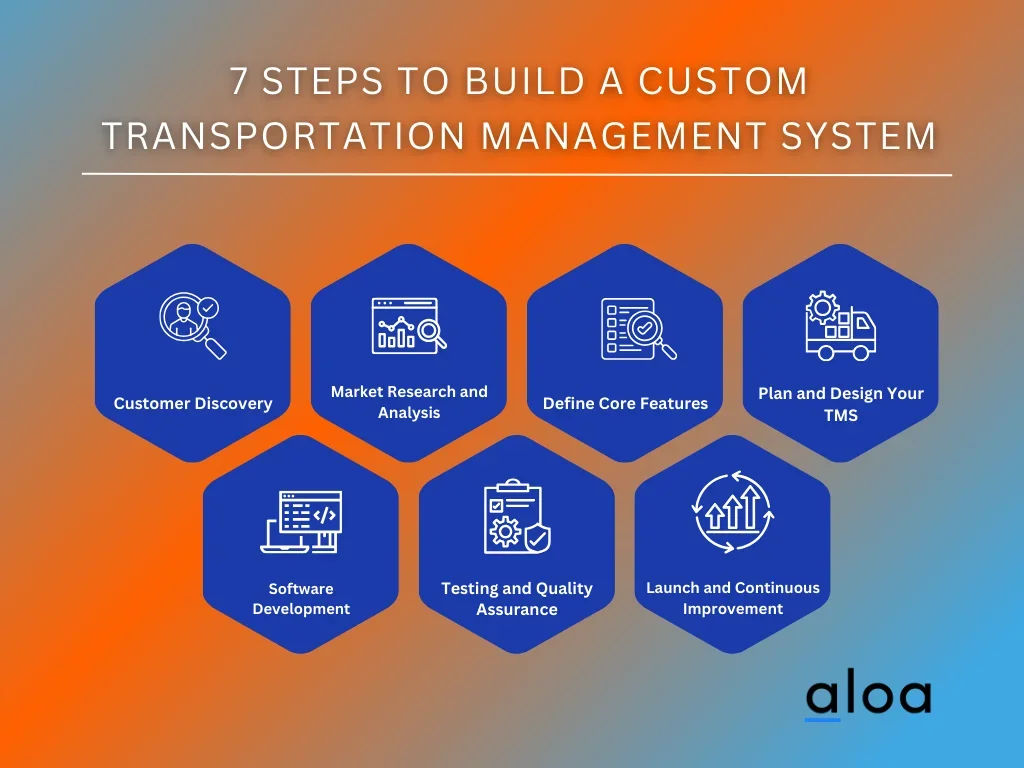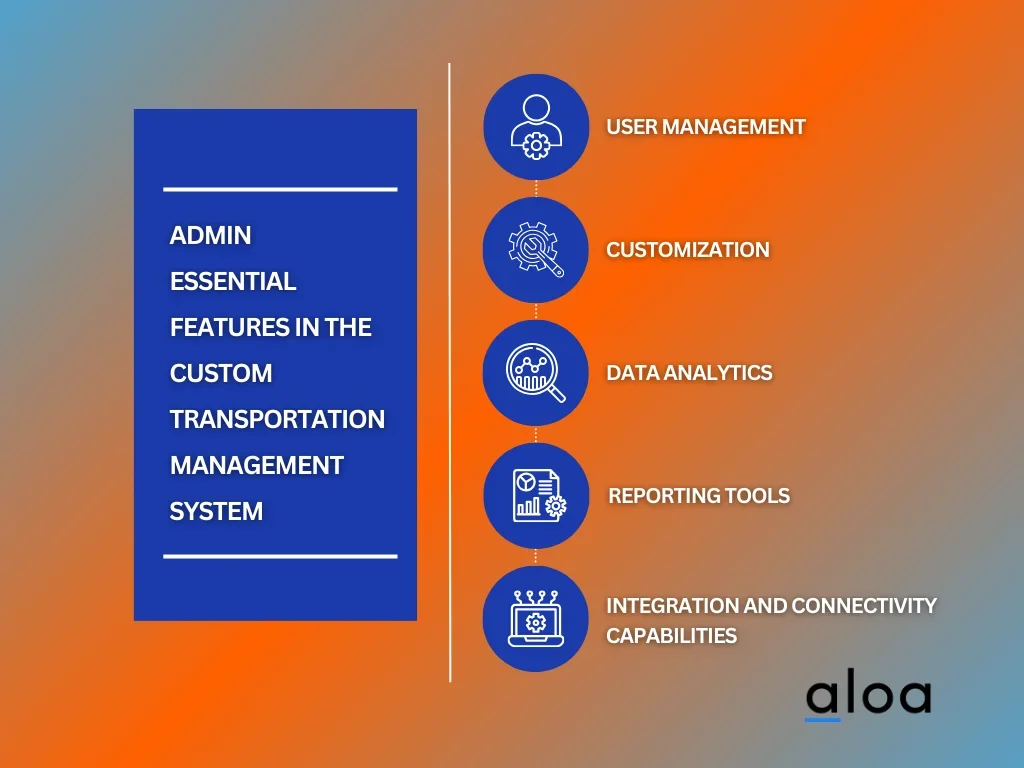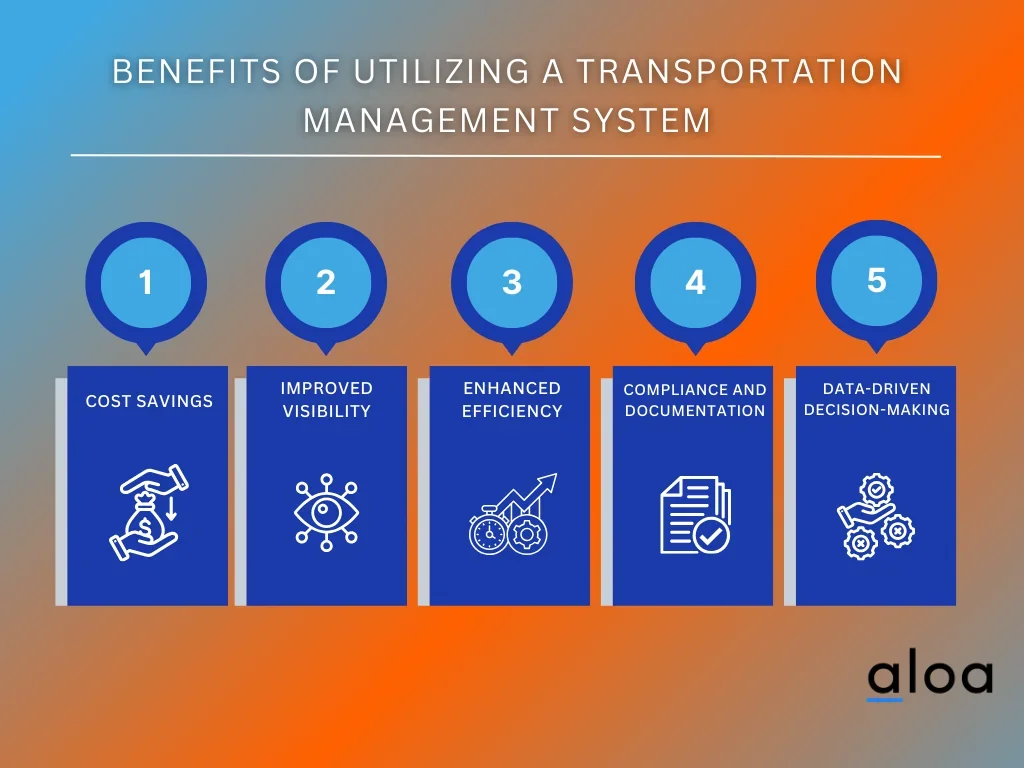As businesses increasingly rely on transportation management system (TMS) to optimize their logistics and supply chain operations, the demand for custom solutions tailored to specific needs is rising.
However, building a custom TMS offers a unique set of challenges and opportunities, from the initial customer discovery phase to the intricate software development process.
A custom transportation management system is often part of a more extensive supply chain management (SCM) system, making it an essential tool for businesses to streamline their operations with transportation management services.
Aloa, a trusted software outsourcing company, offers valuable expertise and resources for building a robust transportation management system (TMS). With a track record of assisting 250+ clients in outsourcing software development, Aloa streamlines the process, saving both time and money, making it an ideal partner for TMS project development.
In this blog, we journeyed through the critical steps and core features for successfully constructing a custom transportation management system. Together, we will unravel the intricacies of TMS development, shedding light on the significance of transportation technology, its myriad benefits, and the imperative steps required to cater to the diverse needs of transport businesses.
By the end of this blog, you’ll have a clear cut starting point on what a TMS is, how to start building an optimized solution, and the essential features to have.
Let's dive in!
7 Steps to Build a Custom Transportation Management System
The shipment industry is at the forefront of innovation, and developing a custom transportation management system has become more crucial than ever. Discover the seven essential steps to guide you through creating an advanced solution tailored to meet the evolving needs of the shipment sector.

Step 1: Customer Discovery
The first step in developing a custom transportation management system is understanding your audience. Before you even think about software, it's essential to grasp the unique needs and challenges of the shipment industry.
Here's how to do it:
- Thorough Research: Start by doing in-depth market research. Understand your competitors, study industry trends, and discover what's happening in the transportation sector.
- Customization is Key: Recognize that not all shipment businesses are the same. Some need tools for generating leads, while others require capabilities for nurturing existing customer relationships.
- Data-Driven Insights: Use data and analytics to better understand the pain points and opportunities within the transit industry. This approach gives you concrete insights into the market.
By pinpointing the intricate details of your audience's needs, you're laying the foundation for a TMS tailored to meet those requirements. Whether it's lead generation tools, nurturing capabilities, or a mix of both, this customer discovery phase is the bedrock on which your development journey rests.
Step 2: Market Research and Analysis
Now that you've gained valuable insights about your target audience, it's time to dig deeper into market research and analysis. This step ensures that your transportation management system aligns seamlessly with the dynamic world of shipment.
Here's how to go about it:
- Competitive Insights: Take a close look at your competition. Understand what they're offering, what works for them, and where they might fall short. This insight will help you position your TMS effectively in the market.
- Industry Trends: Stay on top of the latest trends in the transit sector. This could include new technologies, regulations, or shifts in customer expectations. Keeping up with these trends ensures your system remains relevant.
- Market Alignment: Ensure that your TMS aligns with the ever-evolving needs of the transit sector. It's about more than meeting current requirements but also anticipating future needs.
This phase is crucial in making sure your TMS is not just a one-time solution but an adaptable and forward-thinking platform that's ready for the challenges and opportunities of the shipment industry.
Step 3: Define Core Features
The success of your transportation management system pivots on its core features. It's crucial to define the fundamental elements that your system must incorporate to effectively meet your audience's requirements. These features should align with the specific needs of the transit industry and offer tailored solutions.
Consider features like lead management for businesses seeking to generate leads, automation to streamline processes, robust analytics for data-driven decision-making, user-friendly interfaces for easy navigation, and customization options to cater to end-users and administrators.
By comprehensively defining these core features, you lay the groundwork for a TMS that precisely caters to the diverse demands of the transit sector, ensuring it functions as a strategic asset rather than just another software solution.
Step 4: Plan and Design Your TMS
After defining the core features, the next step in building your custom transportation management system is to embark on the planning and design phase.
Here's what it entails:
- Collaborative Blueprint: Work closely with your development team to create a comprehensive blueprint. This blueprint is a visual representation of your architecture, illustrating how all the components fit together, which is essential for effective Enterprise Resource Planning (ERP).
- User Flows: Define the user flows within your TMS. This involves mapping out the pathways users follow as they interact with the system, ensuring a logical and intuitive experience.
- Functionality: Outline the functionalities your TMS will offer. This includes specifying how each feature will work, what it will accomplish, and how it will interact with other components.
- User Interfaces: Consider the design and layout of user interfaces. These should be user-friendly, providing an intuitive experience for end-users and administrators.
The planning and design phase is crucial in ensuring that your system is functional but also user-friendly and well-structured. It's the blueprint that guides the development of your custom TMS, creating a solid foundation for the upcoming phases of software development and testing. For businesses seeking advanced logistics solutions, partnering with experts in trucking app development can significantly enhance operational efficiency and provide tailored features to meet industry-specific needs.
Step 5: Software Development
With a comprehensive blueprint, it's time to delve into the heart of your project—software development. This pivotal step involves coding, rigorous testing, and continuous refinement to ensure your transportation management system operates seamlessly and efficiently.
The transportation management software development phase is where your vision takes shape and comes to life. It's a dynamic and creative process that combines coding expertise, rigorous testing, and a focus on providing an exceptional user experience. Transportation software development services play a crucial role in optimizing logistics and improving overall efficiency.
Your TMS should be intuitive and easy to navigate for end-users and administrators, enhancing its overall usability. With a user-centric approach and a commitment to refinement, you're on the path to delivering a custom system that meets and exceeds expectations.
Step 6: Testing and Quality Assurance
Before the official launch, rigorous testing and quality assurance are essential to ensure your transportation management system operates seamlessly and meets high standards.
Here are essential aspects to consider:
- Functional Testing: Conduct thorough functional testing to ensure that every feature and component of your TMS is working as intended. This includes testing all user interfaces, automation processes, and data management functions.
- Performance Testing: Assess the performance of your TMS under different conditions, such as various user loads and network speeds. Ensure that it can handle the expected volume of transactions and provide responsive performance.
- Security Testing: Verify that your TMS is secure by conducting comprehensive security testing. Identify vulnerabilities and address them to protect sensitive data and maintain compliance with industry regulations.
By conducting these testing and quality assurance steps with meticulous attention, your TMS will be well-prepared for a successful launch, delivering a reliable and efficient transportation management solution to your users.
Step 7: Launch and Continuous Improvement
The final step in building your custom transportation management system is the launch and continuous improvement phase. This is where your hard work comes to fruition, and your TMS is introduced to the world.
Here are critical considerations to keep in mind during this phase
- Gather User Feedback: Actively seek feedback from the users of your TMS. Listen to their suggestions, concerns, and experiences. This feedback is a valuable source of insights that can guide further enhancements.
- Iterate and Improve: Use the feedback gathered to improve your TMS. Continuously refine and enhance the system to address any issues or to add new features that meet evolving user needs.
- Monitor Performance: Keep a close eye on the performance of your TMS. Monitor how it's meeting the goals and requirements of your users and make adjustments as necessary.
- Stay Current: The transportation industry is ever-evolving. Stay current with the latest trends, technologies, and regulations. Ensure that your TMS remains relevant and compliant.
By launching your TMS confidently and maintaining a commitment to ongoing improvement, you can ensure that your custom solution remains a valuable asset in the ever-changing landscape of the transportation sector.
Essential Features in the Custom Transportation Management System
Transportation management system is the backbone of efficient logistics and transportation operations. To understand the core components of a custom TMS, let's explore the essential features that cater to administrators and users alike.
Features for Admin

- User Management: Streamline user access and permissions, allowing administrators to manage accounts and control system access effectively.
- Customization: Tailor the TMS to meet specific business needs, from defining workflows to configuring processes.
- Data Analytics: Gain valuable insights into transportation operations and carrier performance, as well as trends, through robust data analysis tools.
- Reporting Tools: Generate detailed information in comprehensive reports and documentation for decision-making, compliance, and auditing requirements.
- Integration and Connectivity Capabilities: Seamlessly connect the TMS software with other software systems and services to enhance operational efficiency.
Features for User

- Order and Freight Management: Easily create, track, and manage orders, ensuring a seamless process from order placement to delivery, with integrated tools for efficient freight management and advanced route planning to optimize logistics operations.
- Accurate Time Tracking: Leverage the power of the Internet of Things (IoT) to acquire real-time visibility into order information, delivery time, and carrier systems, enabling informed decision-making.
- Route Optimization: Optimize routes to improve the shipping process by reducing transit time, minimizing fuel consumption, and enhancing overall efficiency.
- Document Management: Upload, access, and manage essential documents, such as invoices and shipping labels.
- Communication Tools: Collaborate effectively with carriers, shippers, and other stakeholders through built-in communication channels.
These core features cater to administrators and users, ensuring a well-rounded TMS experience that enhances logistics and transportation management.
Considerations When Building a Transportation Management System
Building a transportation management system requires careful planning and consideration of various factors to ensure effectiveness. Here are essential considerations when developing a TMS solution.

Scalability
One crucial consideration is the ability of the TMS to scale with your business's growth. Ensure that the system can accommodate an increasing volume of transportation operations and data without performance degradation.
Adaptability
The TMS, enhanced by machine learning, should be adaptable to meet evolving industry requirements and changing regulations. It must be flexible enough to integrate new technologies and adjust to shifting business needs.
User-Friendliness
An intuitive user interface is paramount. Users should be able to navigate the transportation management system with ease and perform tasks efficiently, reducing the learning curve and increasing overall productivity.
Cost-Effectiveness
Consider the total cost of ownership, including initial development, maintenance, and upgrades. A cost-effective TMS should provide a strong return on investment by improving operational efficiency and reducing costs over time.
These considerations are essential to building a TMS that aligns with the unique needs of your transportation and logistics operations while remaining adaptable to future challenges and opportunities.
Benefits of Utilizing a Transportation Management System
Utilizing a transportation management system offers numerous advantages in logistics and transportation. Here, we explore the key benefits of integrating a TMS into your operations.

Cost Savings
A TMS optimizes routes and reduces fuel consumption, leading to significant cost savings, which can be particularly beneficial in cutting down administrative costs. It minimizes empty miles, enhances load optimization, and streamlines transportation expenses.
Improved Visibility
TMS solutions provide real-time tracking and visibility into shipments, allowing for proactive issue resolution and ensuring on-time deliveries, enhancing customer satisfaction.
Enhanced Efficiency
Transportation management system automates various manual processes, including order entry and carrier management, resulting in improved efficiency and reduced administrative workloads.
Compliance and Documentation
TMS systems generate compliance reports and necessary documentation, ensuring adherence to regulations and making audits and reporting tasks more straightforward.
Data-Driven Decision-Making
TMS solutions offer advanced analytics that provide insights into performance and trends, enabling data-driven decision-making and the continuous improvement of logistics operations, often in conjunction with a Warehouse Management System (WMS) for comprehensive supply chain management and streamlined distribution center operations. Incorporating a logistics dashboard within these solutions can further enhance visibility and control, allowing managers to monitor key performance indicators in real-time and make informed decisions quickly.
By leveraging a TMS, businesses can streamline their transportation operations, reduce costs, and enhance customer service, ultimately gaining a competitive edge in the complex world of logistics. Also, integrating with a route planning app like MyRoute Online, will help save on costs and result in faster delivery times.
Key Takeaway
Building a successful transportation management system revolves around tailoring your solution to the specific needs of the transportation and logistics industry. It can be tough to build a supply chain management plan. Whether you're focused on optimizing routes, enhancing real-time tracking, or streamlining communication, TMS addresses them effectively by centralizing and organizing transportation data.
Aloa, a proficient proponent in developing tailored transportation management system solutions, stands ready to elevate your transportation and logistics operations. We specialize in crafting TMS solutions that align with the unique requirements of your business. Whether you are a startup looking to establish efficient transportation processes or a logistics company seeking enhanced solutions, Aloa's expertise is your key to success.
Contact us at [email protected] to explore how we can assist you in your journey toward a dynamic and efficient transportation management system.

